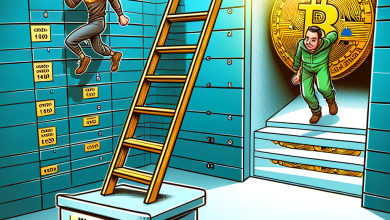Fear: Fluctuation Index is now measured daily
It is world-renowned as a “fear index”: The volatility index “VIX” of the US derivatives exchange CBOE (Chicago Board Options Exchange) from Chicago. Bestselling author Robert Harris has dedicated a fascinating thriller to the index (“Fear Index”). Pay TV broadcaster Sky even made a TV series out of it.
The definition of the VIX doesn’t exactly sound like a blockbuster: The index indicates the fluctuation intensity of the stocks from the S&P 500 expected by the options market over 30 days as a percentage. In short: the higher the value, the greater the price swings investors expect – and vice versa. These expectations can be read from options prices. With such options, large investors buy or sell the right to buy (call option/call) or sell (put option/put) a certain number of shares at an agreed price within a specified period of time.
The fear is not particularly great at the moment, at least that is what the VIX suggests: the index has risen from 18 to 23 percent since the beginning of the year, but is well below panic rates. In the corona crash of spring 2020, for example, it was well over 80, even based on daily rates.
There is always a touch of mystery surrounding the VIX. Many think it reveals hidden insights. Some believe the market experts know more than ordinary investors — and that they are giving away that knowledge about options prices, which in turn would affect the VIX.
In a way, the VIX is a clinical thermometer. This indicates a fever when the temperature has already risen – not before. After all, investors also adjust their expectations for the future when something has already happened. Very few people have a crystal ball with which to look into the future.
The VIX gets an offshoot
In the previous VIX, options with longer maturities were taken into account. The index did not express the short-term fluctuation expectations, but the expectations for the next 30 days – albeit in real time and constantly updated.
But that has now changed with an offshoot, the VIX1d. It expresses the fluctuation expectations from a one-day perspective, so it represents a much shorter-term perspective. The index swings are also likely to be significantly larger in the VIX offshoot. Because on a 30-day view, short-term fluctuations are smoothed out. On a one-day view, however, they hit the ground running.
So why the new index? The truth is probably because the VIX and its offshoot for the CBOE exchange are good business above all. A year ago, the exchange launched special one-day options on the S&P 500 (called “zero-day options” in the jargon). They have been extremely successful with investors. Short-term options make up 40 percent of the options market. Clearly, then, the CBOE struck a chord with investors. The VIX offshoot is the logical consequence.
Toys for speculators?
Precisely because the VIX always rises when prices fall, it also forms the basis for a large number of speculations. It is true that nobody can directly buy the VIX as an index. But there are, for example, index funds (ETFs) and other index investments that are based directly on its development.
So, does the new one-day VIX now offer much better opportunities to protect against short-term swings? Anyone asking local asset managers for their opinion on the new VIX offshoot will encounter a lot of skepticism – if not outright rejection.
This is due to the design of the VIX. The VIX has so far been calculated from the supply and demand for options with different maturities and strike prices. When there are many buyers, options become more expensive and the VIX rises with it. Ultimately, the expectations were then converted to the 30-day view.
Unpredictable daily fluctuations
Predicting the daily fluctuation of stock market prices, as is now necessary with the VIX offshoot, is a sporting task. Even with important decisions by the central banks, the publication of inflation data or political decisions, stock market traders’ expectations are rarely met. There are brief blips before prices settle at certain levels. With the new VIX offshoot, there is a high risk that rather random price movements can affect the index. Should investment products on the new VIX offshoot possibly also be offered in Germany in the future, appropriate caution is required.
Robert Beer seems almost certain that such offers will soon be available. The asset manager from Weiden in der Oberpfalz sees one-day options as just a toy for speculators, not a real investment. “Investors should better go to the casino and bet on red or white,” says Beer. The chance of winning is just as small. Ideally, the whole thing would at least be fun.
USA offer freedom to gamble
In the US, private investors are also speculating with options. That’s why enthusiasm for the VIX is even greater there than in Germany, says Matthias Kunze, Managing Director at Assenagon. Assenagon offers the Alpha Volatility fund as a strategy primarily for large investors. The strategy promises returns precisely when stocks or bonds are having a hard time. If the stock market falls sharply within a short period of time, the fund price rises accordingly – for example in the corona crash. The fund managers Daniel Danon and Tobias Knecht really only try to reflect the expected fluctuations. To do this, they buy options on shares, but hedge other influencing factors such as the share price, currency developments and interest rate dependencies. This makes volatility the main driver of fund performance.
This works especially well in bad stock market times. In 2022, the duo benefited from the crash in tech stocks. In early March, it was betting more on the volatility of US investment banks. This bet also paid off with the bank crash in the USA and the turbulence surrounding Credit Suisse in Switzerland.
Funds as crash insurance
The fund is geared towards an extreme event, the often quoted “black swan”. It has proven itself in the corona crisis and the Ukraine shock. With an initial investment of EUR 100,000, it can make large portfolios robust. If you can’t raise that much money for a hedge, you don’t have to worry: In the long run, investors won’t earn much with the fund. It’s the insurance that makes you happy when you don’t need it.
But even the volatility professionals find little to gain from the new VIX offshoot. “The one-day options are irrelevant to us and have no impact on our strategy,” says Assenagon’s Kunze.
If things go really badly, the new trend towards short-term investing could even increase the volatility of the market and thus of the fund. Something like this has also happened in the past. Sometimes the VIX develops a life of its own and then it becomes surreal. Like in February 2018: At that time, the range of price fluctuations on the markets suddenly rose to a level that only occurs once every few years. The VIX reached extreme values. At that time, however, many investors had opted for low volatility. With the VIX’s sudden rise, these bets collapsed – losing up to 95 percent. The providers of such bets attempted to stem the VIX rise but appeared to be amplifying the trend. The stock prices in New York fluctuated more and more, the betting providers had to protect themselves against even greater nervousness. They did this, among other things, with panic sales on the stock market.
In addition, the stock market dominating computer-aided trading systems came into play. These algorithm-driven systems react bluntly: when volatility increases, they sell risky positions like stocks and switch to safer assets like bonds. That’s exactly what happened. While the Dow Jones crashed, US government securities went up significantly.
What is happening around the VIX can also have consequences for the entire capital market. The concern is that this impact could increase with the daily options and the VIX1d. In the one-year trial phase with the daily options, however, there were no undesirable side effects.
The cause of the turbulence at the time: Credit Suisse. At that time, investors had lost 80 percent, and the Credit Suisse share lost three billion euros in market value within a few days. Such events contributed to the bank’s descent, which was sealed with its takeover by UBS in March.
By the way, the VIX remained surprisingly stable there. There was only a brief twitch to descend. Why? That will probably remain his secret.
Also read: How nervous investors increase the risk of a crash





